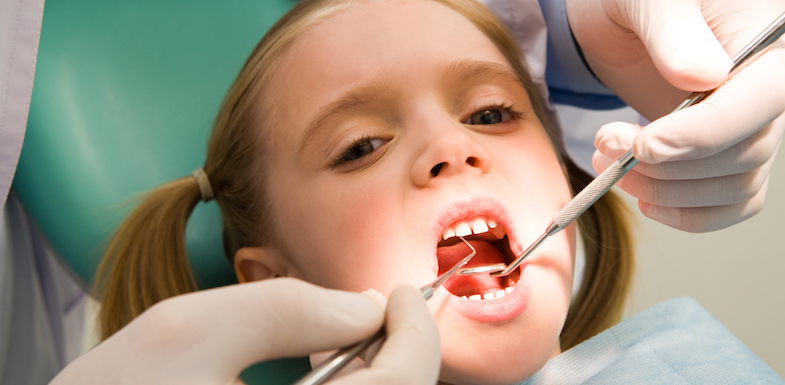Noticing a strange bump in our children’s mouths can be unsettling. If we are diligent with gum cleaning even in the youngest members of our families and visit our dentist as scheduled, it seems like they should have relatively few problems. In most cases, an eruption hematoma occurs through no fault of our own, though. Here’s what you need to know about this condition.
What is an eruption hematoma?
An eruption hematoma is a type of dental cyst that mainly appears over erupting baby (primary) and permanent teeth. While eruption cysts are usually clear, eruption hematomas have blood mixed into the clear fluid.
They range in color from bluish to deep purple or black. This soft tissue lesion forms on the gum in the area where the erupting tooth is located. Eruption hematomas may be small but their color makes them stand out on the alveolar ridge.
Dental cysts with clear fluid are very common in teething children. An eruption hematoma that contains blood usually has another underlying condition that would cause bleeding, such as:
- Early caries: Especially for children, early caries (cavities) can be a primary cause of eruption cysts.
- Trauma: Trauma to the mouth can cause accumulation of fluid that may linger. When accompanied by bruising, an eruption hematoma can result.
- Infection: Infection accompanied by swelling can cause fluid to build up.
- Crowding: If there is not enough space for teeth to erupt, the pressure can cause fluid to build up, forming an eruption cyst.
- Inflammation of periapical tissue: Inflammation of the tissue surrounding the tooth’s roots may cause an eruption cyst to form.
How can I tell if it’s an eruption hematoma?
All dental cysts occur most commonly in children between the ages of six and nine, with some indications that males experience them more often than females.
Common symptoms of a dental hematoma are similar to the symptoms of tooth eruptions, including:
- Drooling
- Swollen gums
- Fussiness or irritability
- Sleep issues
- Painful ears and cheeks
- Desire to chew on cold or hard surfaces
Rare symptoms include low-grade fever and symptoms that are similar to respiratory infection (e.g., nasal congestion, a feeling of fullness in the ears).
All of the symptoms above may be present with a normal tooth eruption. What separates a dental hematoma from a normal tooth eruption is the discolored swelling located in the soft tissue directly above the erupting tooth. An eruption cyst is clear and usually not discolored, but an eruption hematoma has as a primary feature discoloration.
What are common eruption hematoma treatments?
Prevention of an eruption hematoma is similar to prevention of any type of dental cysts.
Avoiding early caries by limiting or eliminating sugary drinks (including juice) and carefully cleaning baby’s gums regularly will help keep erupting teeth healthy. While it is difficult to avoid all injuries in children, making sure your child has plenty of soft toys to play with is also helpful. Before they gain control of their movements, babies may injure themselves with hard blocks or plastic toys.
Other eruption hematoma treatment options range from no intervention to more aggressive treatments.
The wait-and-see approach
Because many dental cysts resolve themselves once the erupting tooth breaks through the cyst, this is a common approach.
This option works well for smaller eruption hematomas that are not causing excessive pain or interfering with normal function.
Home remedies
Cold teething rings with a drop or two of peppermint, clove, or chamomile oil can help relieve pain and inflammation.
Rubbing gums with a washcloth soaked in salt water can help keep the area clean.
Over-the-counter medication for pain
If the eruption hematoma is causing pain, taking ibuprofen or acetaminophen can help ease the pain.
For children, use caution when utilizing pain medications, and follow your doctor’s instructions carefully.
Gum massage
In some cases, gentle massage with a warm washcloth may help the eruption hematoma begin to resorb. Massage may also cause the cyst to burst. If this occurs, rinsing gently with mildly salted water can help clean it out.
This is only advised for children who are able to swish and spit. For babies or younger toddlers, wipe with a clean cloth and give your Phoenix area pediatric dentist a call for any further instructions.
Medications
If there are signs of infection (e.g., high fever, fussiness, excessive pain and swelling), medications may be necessary.
AZ Dentist believes in conservative use of antibiotics for young patients, but in the case of infection, antibiotics are an important way to prevent complications.
Surgical intervention
For dental hematomas that remain after the tooth has erupted, surgical intervention may be your best option. The goal of a surgical intervention is to drain the eruption hematoma and thoroughly clean the area to prevent infection.
Your dentist will do this in four steps:
- Topical anesthetic is applied for small children
- A small incision is made either with a sterile scalpel or a laser
- The incised area is thoroughly cleaned to prevent infection
- If there is residual skin that may be uncomfortable or cause other issues, this is removed
For most patients, this surgical intervention is not necessary and is a last resort.
Teething babies may find relief and resolve the eruption hematoma on their own by chewing on cold washcloths or other teething tools. For some children, simply being distracted can help if they are experiencing pain.
We do understand that seeing your child in pain can be distressing. If you require an emergency dentist in the Phoenix area, we’ve got you covered.
Give AZ Dentist a call to schedule an appointment today.
